Unsolved Numerical Problems from GK PUBLICATIONS PHYSICS Chapter 6 GEOMETRICAL OPTICS for Class 12
| Class 12 | PHYSICS |
| Chapter | GEOMETRICAL OPTICS |
| GK PUBLICATIONS PHYSICS | Unsolved Numerical Problems |
| Medium | English |
| Academic Year | 2023-2024 |
Question 6
A solid glass sphere with radius R and an index of refraction 1.5 is silvered over one hemisphere. A small object is located on the axis of the sphere at a distance 2R to the left of the vertex of the unsilvered hemisphere. Find the position of final image after all refractions and reflection have taken place. View SolutionQuestion 8
A source of light is located at double focal length from a convergent lens. The focal length of the lens is f=30cm. At what distance from the lens should a flat mirror be placed, so that the rays reflected from the mirror are parallel after passing through the lens for the second time? View SolutionQuestion 9
A parallel beam of rays is incident on a consisting pf three thin lenses with a common optical axis. The focal length of the lenses are equal to f1=+10cmandf2=−20cm,andf3=+9cm respectively. The distance between the first and the second lens is 15cm and between the second and the third is 5cm. Find the position of the point at which the beam converges when it leaves the system of lenses. View SolutionQuestion 10
A ray of light is incident on the left vertical face of glass cube of refractive index n2, as shown in figure. The plane of incidence is the plane of the page, and the cube is surrounded by liquid (refractive index=n1). What is the largest angle of incidence θ1 for which total internal reflection occurs at the top surfaces? View Solution
View SolutionQuestion 12
In an isosceles prism of prism angle 45∘, it is found that when the angle of incidence is same as the prism angle, the emergent ray grazes the emergent surface. Find the refractive index of the material of the prism.For what angle of incidence the angle of deviation will be minimum ?View SolutionQuestion 13
An astronomical telescope with objective of focal length 100 cm and eyepiece of focal length 10 cm is used by a shortsighted man whose far point is 33 cm from his eye, to form an image of an infinitely distant object at his far point. Find the separation of the lenses, and magnification obtained.View SolutionQuestion 16
A ray of light strikes a glass slab of thickness t.
(i) Prove that it emerges on the opposite face, parallel to the initial ray.
(ii) (ii) Prove that the value of deflection of beam which passed through the plate is :
tsini1⎡⎢⎣1− ⎷(1−sin2i1.aμ2g−sin1i1)⎤⎥⎦
(iii) Prove that for a small angle of incidence i1, the internal shift x is given by
x=ti1(1−1.aμg)
where .aμg is the refractive index of glass with respect to air.View SolutionQuestion 17
A plano-convex lens has thickness 4cm. When places on a horizontal table with the curved surface in contact with it, the apparent depth of the bottom-most point of the lens if found to be 3cm. If the lens is inverted such that the plane face is in contact with the table, the apparent depth of the center of the plane face of the lens is face of the lens is found to be 25/8 cm. Find the focal length of the lens. View SolutionQuestion 18
An image Y is formed of a point object x by a lens whose optic axis is AB as shown in Figure. Draw a ray diagram to locate the lens and its focus. If the image Y of object X is formed by a concave mirror (having the same optic axis AB) instead of lens, draw another ray diagram to locate the mirror and its focus. Write down the steps of construction of the ray diagrams.
 View Solution
View SolutionQuestion 19
A thin plano-convex lens.of focal length f is split into two halves : One of the halves is shifted along the optical axis (figure)The separation between object and image planes is 1.8m.The magnification of the image formed by one of the half lensis 2. Find the focal length of the lens and separation between the two halves. Draw the ray diagram for image formation.
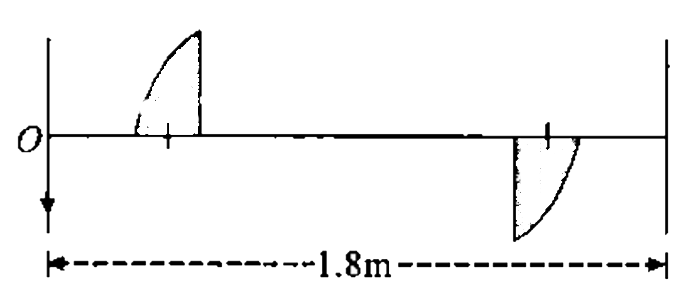 View Solution
View SolutionQuestion 20
The focal lengths of the objective and the eye piece of a compound microscope are 1cm and 5cm respectively. An object placed at a distance of 1:1 cm from the objective has its final image formed at (i) infinity (ii) least distance of distinct vision. Find the magnifying power and the distance between the lenses. Least distance of distinct vision is 25 cm.View SolutionQuestion 23
AB is a man of height 2m and M is a mirror of length 0.5m and mass 0.1 kg. Initially top of mirror M and A are at the same level and the M starts falling freely always remaining vertical. If the level of the eyes of the manis 1.5 cm below his head. A, find the time after which the man sees the reflection of his feet.
 View Solution
View SolutionQuestion 30
A crown glass prism of refracting angle 8∘ is combined with a flint glass prism to obtain deviation without dispersion. If the refractive indicates for red and violet rays for the crown glass are 1.514 and 1.524 and for the flint glass are 1.645 and 1.665 respectivey, find the angle of flint glass prism and net deviation.View SolutionQuestion 35
Figure shows a torch producing a straight light beam falling on a plane mirror at an angle 60∘ The reflected beam makes a spot P on the screen along y-axis . If at t=0, mirror starts ratating about the hinge A with an angular velocity (ω)=1∘ per second clockwise. Find the speed of the spot on screen after time t = 15 s.
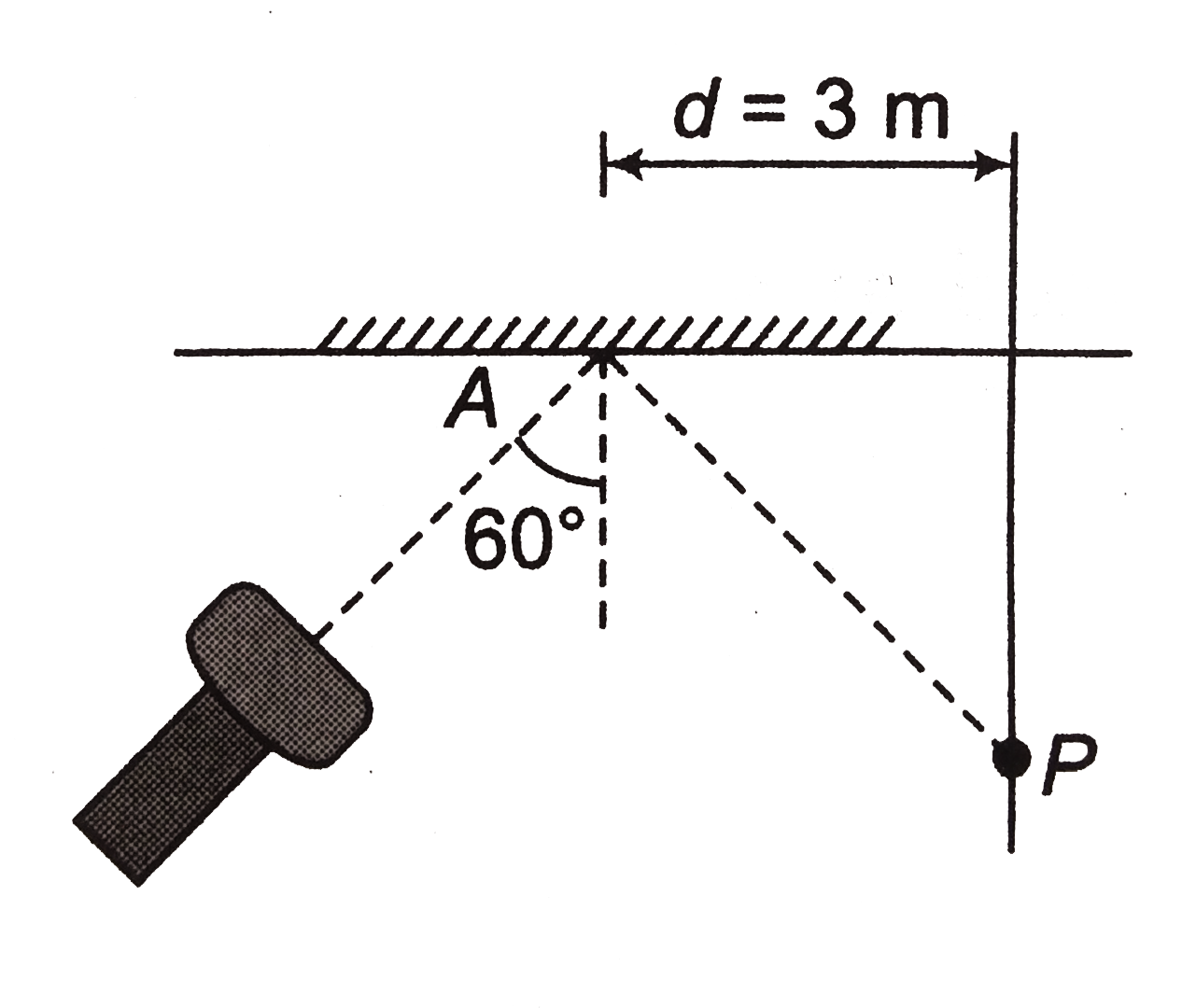 View Solution
View SolutionQuestion 36
A light ray I is incident on a plane mirror M.The mirror is rotated in the direction as shown in the figure by an arrow at frequency 9πrev/sec,The light reflected by the mirror is received on the wall W at a distance 10mfrom the axis of rotation .When the angle of incidence becomes 37∘find the speed of the spot (a point) on the wall?
 View Solution
View SolutionQuestion 37
A spherical light bulb with a diameter of 3.0cm radiates equally in all the directions with a power of 4.5πW.(a find the light intensity of the surface of the bulb.(b) Find the light set up with its axis pointing towards the bulb.The lens has a circular face with a diameter of 15.0cmand a focal length of 30.0cmFind the diameter of the image of the bulb formed on a screen kept at the location of the image .(d)Find the light intensity at the image.View SolutionQuestion 38
A coin lies on the bottom of a lake 2 m deep at a horizontal distance x from the spot light S which is a source of thin parallel beam of light situated 1 m above the surface of the liquid of refractive index p= as shown in figure. The liquid height is 2m. Find x so that a narrow beam of light from S when incident on the liquid surface at incidence angle 45∘ fells directly on the coin
 View Solution
View SolutionQuestion 43
in figure shown AB is a plane mirror of length 40cm placed at a height 40cm from ground . There is a light source S at a point on the ground ,Find the maximum and minimum height of a man(eye height)required to see the image of the source If he is standing at a pointA on ground shown in figure.
 View Solution
View SolutionQuestion 44
A plane mirror of circular shape with radius r=20cm is fixed to the ceiling .A bulb is to be placed on the axis of the mirror.A circular area of radius R=1m on the floor is to be illuminated after reflection of light from the mirror. The height of the room is 3m What is maximum distance from the center of the mirror and the bulb so that the required area is illuminated?View SolutionQuestion 45
A room contains air in which the speed of sound is 340m/s. The walls of the room are made of concrete in which the speed of sound is 1700m/s (a) Find the critical angle for total internal refection of sound at the concrete-air boundary.(b) in which medium must the sound be travelling to undergo total internal reflection?View SolutionQuestion 50
A convex lens of focal length 1.5m is placed in a system of coordinate axis such that its optical centre is at origin and principa, axis coinciding with the x-axis. An object and a plane mirror are arrange on theh principal axis as shown in figure. Find value of d (in m) so that y-coordinate of image (after refraction and reflection ) is 0.3m. (Take tanθ=0.3)
 View Solution
View SolutionQuestion 51
A ray in incident normally on a right angle prism whose refractive index is √3 and prism angle α=30∘. After crossing the prism, ray passes through a glass sphere. It strikes the glass sphere at R√3 distance from principal axis, as shown in the figure. The is half polished. Find the totol angle of deviation of the incident ray after all reflections and refractions from this optical setup
 View Solution
View SolutionQuestion 53
A stationary observer O looking at a fish F in water (μw=4/3) through a converging lens of focal length 90.0cm . The lens is allowed to fall frelly from a height 62.0cm with its axis vertical. The fish and the observer are on the principal axis of the lens. The fish moves up with constant velocity 100cm/s. Initially it was at depth of 44.0cm . Find the velocity (in cm//s) with which the fish appears to move with respect to lens to the observer at t=0.2s. (take g=10m/s2)
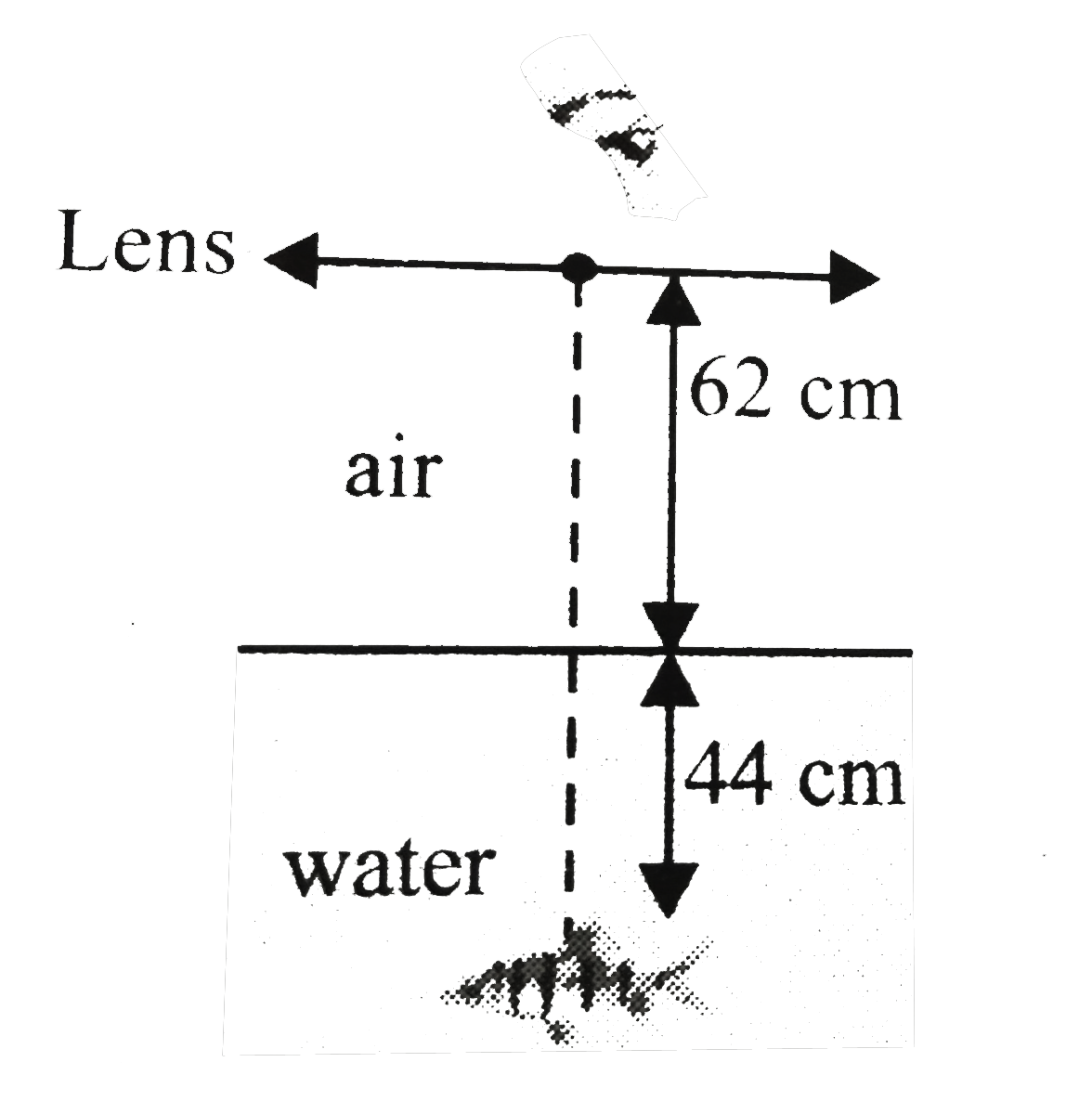 View Solution
View SolutionQuestion 54
An equilateral prism ABC is placed in air with its base side BC lying horizontally along x-axis as shown in the figure. A ray given by √3z+x=10 is incident at a point P on the face AB of the prism
(a) Find the value μ from which the ray grazes the face AB
(b) Find the direction of the initially refracted ray if μ=32
(c) Find the equation of ray coming out of the prism if bottom BC is silvered ?
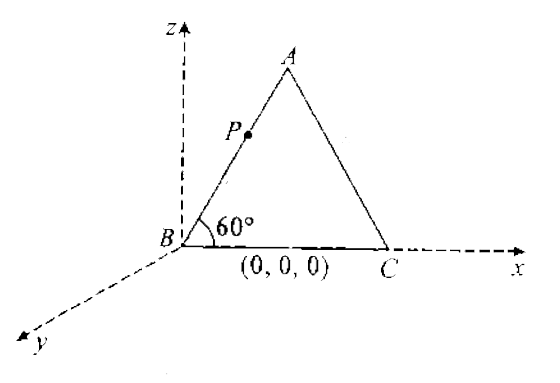 View Solution
View SolutionQuestion 55
A convex lens of focal length 20 cm and a concave lens of focal length 10 cm are placed 10 cm apart with their principal axes coinciding. A beam of light travelling parallel to the principal axis and having a beam diameter 5.0 mm, is incident on the combination. Show that the emergent beam is parallel to the incident one. Find the beam diameter of the emergent beam. View SolutionQuestion 56
A thin convex lens of refractive index μ=1.5 is placed between a point source of Light S and a screen A, shown in figure,. Light rays from the source S are brought to focus on the screen A, forming a point image P. The distance SP is equal to 50cm. Water (μ=4/3) is now poured into a vessel interposed between the object and the lens, and it is observed that when the water level is 8cm the screen has to be moved up by a distance of 6cm in order to get a sharp image. Find the focal length of the lens.
 View Solution
View SolutionQuestion 57
A thin equiconvex glass lens (μg=1.5) is beign placed on the top of a vessel of height h=20cm as shown figure. A luminous point source is beign placed at the bottom of vessel on the principal axis of the lens. When the air is on both the side of the lens the image of luminous source is formed at a distance of 20cm from the lens out side the vessel. When the air inside the vessel is being replaced by a liquid of refractive index μl the image of the same source is being formed at a distance 30cm from the lens outside the vessel. Find the μl.
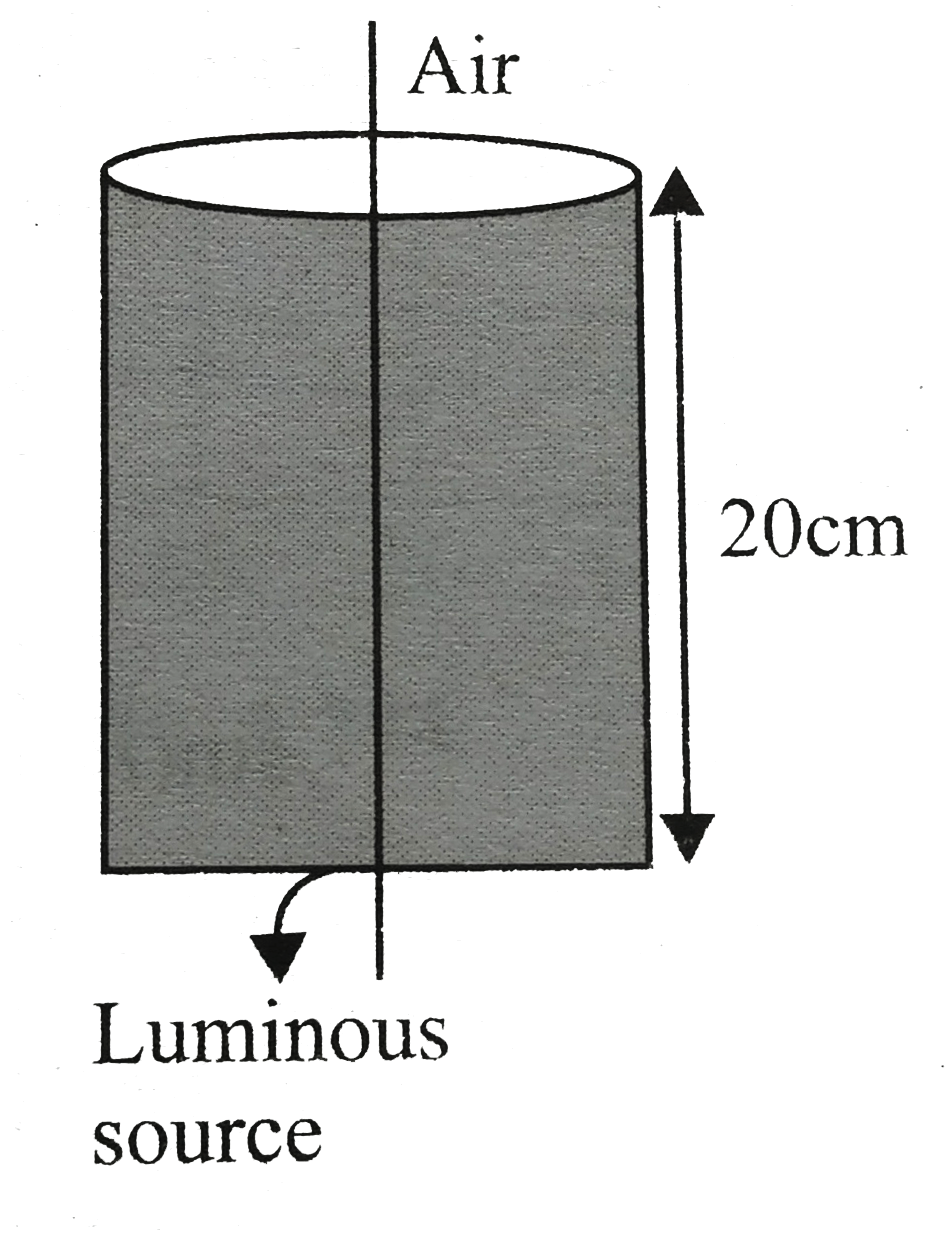 View Solution
View SolutionQuestion 58
Light passes symmetrically through a 60∘ prism of refractive index 1.54. After emergence out from the prism the light ray is incident on a plane mirror fixed to the base of the prism extending beyond it. Find the total deviation of the light ray after reflection from the mirror.View SolutionQuestion 59
A glass rod has ends as shown in figure. The refractive index of glass is μ. The object O is at a distance 2R from the surface of larger radius of curvature. The distance between apexes of ends is 3R. Find the distance of image formed of the point object from right hand vertex. What is the condition on μ for formation of a real image
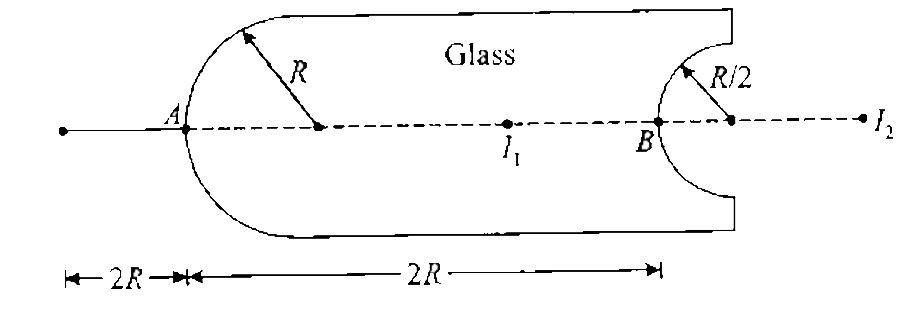 View Solution
View SolutionQuestion 60
When the object is placed 4 cm from the objective of a microscope, the final image formed coincides with the object. The final image is at the least distance of distinct vision (24 cm). If the magnifying power of the microscope is 15, calculate the focal lengths of the objective and eye-piece.View SolutionQuestion 61
A hemispherical portion of the surface of a solid glass sphere (mu = 1.5) of radius r is silvered to make the inner side reflecting. An object is placed on the axis of the hemisphere at a distance 3r from the centre of the sphere. The light from the object is refracted at the unsilvered part, then reflected from the silvered part and again refracted at the unsilvered part. Locate the final image formed. View SolutionQuestion 62
The focal lengths of the objective and the eye-piece of an astronomical telescope are 0.25 m and 0.02m, respectively. The telescope is adjusted to view an object at a distance of 1.5 m from the objective, the final image being 0.25 m from the eye of the observer. Calculate the length of the telescope and the magnification produced by it.View SolutionQuestion 63
A convex lens of focal length 1.5m is placed in a system of coordinate axis such that its optical centre is at origin and principa, axis coinciding with the x-axis. An object and a plane mirror are arrange on theh principal axis as shown in figure. Find value of d (in m) so that y-coordinate of image (after refraction and reflection ) is 0.3m. (Take tanθ=0.3)
 View Solution
View SolutionQuestion 64
A ball is kept at a height h above the surface of a heavy transparent sphere made of a material of refractive index The radius of the sphere is R. At t = 0, the ball is dropped to fall normally on the sphere. Find the speed of the image formed as a function of time for t<√2hg. Consider only the image by a single refraction. View SolutionQuestion 69
An astronomical telescope consisting of two convex lenses of focal length 50 cm and 5cm is focussed on the moon. What is the distance between the two lenses in this position ? If the telescope is then turned towards an object 10 m a way, how much would the eye-piece have to be moved to focus on the object without altering the accommodation of the eye ? Calculate the angular magnification produced by the telescope in the two adjustments.View SolutionQuestion 72
An astronomical telescope in normal adjustment hasa tube length of 93 cm and magnification (angular) of 30. If the eye-piece is to be drawn out by 3 cm to focus a near object, with the final image at infinity, find how far away is the object and the magnification (angular) is this case.View SolutionQuestion 73
The focal lengths of the objective and the eye-piece of an astronomical telescope are 0.25 m and 0.025 m, respectively. The telescope is focussed on an object 5m from the objective, the final image being formed 0.25 m from the eye of the observer. Calculate the length of the telescope and its magnifying power.View SolutionQuestion 74
A Keplerian telescope with magnification T=15 was submerged into water which filled up the inside of the telescope. To make the system work as a telescope again within the former dimensions, the objective was replaced. What has the magnification of the telescope become equal to ? the refractive index of the glass of which the ocular is made is equal to n=1.50.View SolutionQuestion 76
The redius of curvature of the convex face of a plano-convex lens is 12cm and its refractive index is 1.5.
a. Find the focal length of this lens. The plane surface of the lens is now silvered.
b. At what distance form the lans will parallel rays incident on the convex face converge?
c. Sketch the ray diagram to locate the image, when a point object is places on the axis 20cm from the lens.
d. Calculate the image distance when the object is placed as in (c). View SolutionQuestion 77
An object is at a distance of a=36 cm from a lens with a focal length f=30 cm. A flat mirror turned through 45∘ with respect to the optic axis of the lens is placed behind at a distance of l=1m. At what distance h from the optic axis should the bottom of a tray filled with water upto depth 20 cm be placed to obtain a sharp image of the object at the bottom ?
 View Solution
View SolutionQuestion 79
An object is placed 20 cm to the left of a convex lens of focal length 10 cm. If a concave mirror of focal length 5cm is placed 30 cm to the right of the lens, find the magnification and the nature of the final image. Draw the ray diagram and locate the position of the image.View SolutionQuestion 80
A glass sphere with centre O is shown in the figure, AOB and COD are two diameters at right angles to each other. A ray parallel to AOB strikes the sphere at P, a point mid-way between A and C. After refraction, it proceeds along PB. Find

(a) The path of ray beyond B,
(b) The refractive index of glass, and
(c) The deviation of the ray as it emerges out of the sphere.View SolutionQuestion 81
A hollow sphere of glass of inner and outer radii R and 2R respectively has a small mark on its inner surface. This mark is observed from a point outside the sphere such that the centre of the sphere lies in between. Prove that the mark will appear nearer than it really it, by a distance (μ−1)(R)/(3μ−1)View SolutionQuestion 82
Two thin similar watch glass pieces are joined together,front to front ,with near convex portion silvered and the combination of glass pieces is placed at a distance a=60cm from a screen.A small object is placed normal to the optical axis of the combination such that its image is two time the object. Now water is filled in between the glass. waterμ=4/3,calculated the distance through,which the object must be displayed so that a sharp image is again formed on the screen.View SolutionQuestion 86
A concave lens of focal length 20 cm is placed 15 cm in front of a concave mirror of radius of curvature 26 cm and further 10 cm away from the lens is placed an object. The principal axis of the lens and the mirror are coincident and the object is on the axis Find the position and nature of the image.View SolutionQuestion 87
A double convex lens is placed on a horizontal plane mirror. A pin held horizontally above the lens coincides with its own image when it is 18cm from the lens. The space between the lens and the mirror is filled with glycerine and water, turn by turn, and the positions of coincidence of the pin with the image are 28 cm and 24 cm from the lens, respectively. Calculate the refractive index of glycerine, given that the refractive index of water is 4/3.View SolutionQuestion 90
A ray is incident on a glass sphere as shown.The opposite surface of the sphere is partially silvered .If the net deviation of the ray transmitted at the partially silvered surface is 1/3rdof the net deviation suffered by the ray reflected at the partially silvered surface(after emerging out of the sphere).Find the refractive index of the sphere.
 View Solution
View SolutionQuestion 92
A convex lens of crown glass is perfectly cemented to a plano-concave lens of flint glass to form an achromatic combination of power ÷5D. Calculate the radii of curvature of the convex lens from the following data.
Refractive indexDispersive powerCrown glass 1.50 0.1Flint glass 1.60 0.02View SolutionQuestion 93
A converging system of convex lenses free from chromatic aberration and of focal length 2.5 cm is to be constructed by using a convex lens of focal length 2 cm and dispersive power 0.04 and another convex lens of dispersive power 0.03. What should be the focal length of the second lens and at what distance from the first lens should it be placed ?View SolutionQuestion 96
In a direct vision spectroscope there are two flint glass prisms each of angle 5∘ and dispersive power 0.36 and two crown glass prisms of dispersive power 0.24. Calculate the angle of each crown glass prism and the net dispersion produced by the system of prisms. (μcrown=1.5andμflint=1.68)View SolutionQuestion 97
An achromatic doublet of focal length 50 cm is used as an objective of a telescope. The refractive indices of the glasses of the lenes for yellow are 1.6 and 1.5. The radius of curvature of the sides on contact is 15 cm. Find the radii of curvature of the other surfaces. The dispersive powers of the glasses are 0.33 adn 0.24.View SolutionQuestion 98
A ray of light incident normally on one of the faces of a right-angle isosceles prism is found to be totally reflected as shown in the figure. What is the minimum value of the refractive index of the material of the prism? When the prism is immersed in water, trace the path of the emergent ray for the same incident ray, indicating the values of all the angles (μω=4/3).
 View Solution
View SolutionQuestion 99
In a double slit experiment ,the separation between the slits is d=0.25cm and the distance of the screen D=100cm from the slits .if the wavelength of light used in λ=6000Åand I0is the intensity of the central bright fringe.the intensity at a distance x=4×10−5in form the central maximum is-View SolutionQuestion 102
A compound microscope has an objective of focal length 2 cm and eye-piece of focal length 5 cm. The distance between the two lenses is 25 cm. If the final image is at a distance of 25 cm from the eye-piece, find the magnifying power of the microscope. What would be the magnifying power if the microscope were reversed ?View SolutionQuestion 103
A convex lens of focal length 15cm is placed in front of a convex mirror. Both are coaxial and the lens is 5cm from the apex of the mirror. When an object is placed on the axis at a distance of 20cm from the lens, its is found that image coincides with the object. Calculate the radius of curvature of mirror.
[55cm]View SolutionQuestion 104
An object of height 4 cm is kept to the left of and on the axis of a converging lens offocal length 10cm at a distance of 15cm from lens. A plane mirror is placed inclined at 45∘ to the lens axis, 10 cm to the right of the lens.Find the position and size of the image formed by the lens and mirror combination. Trace the path ofthe rays forming the image. View SolutionQuestion 106
A point source of light S is placed at the bottom of a vessel containing a liquid of refractive index 5/3. A person is viewing the source from above the surface. There is an opaque disc of radius 1cm floating on the surface. The centre of disc lies vertically above the source O. The liquid from the vessel is gradually drained out through a tap. What is the maximum height of the liquid for which the source cannot be seen at all. View Solution
All Exercises from GK PUBLICATIONS PHYSICS Class 12 PHYSICS GEOMETRICAL OPTICS
- Advance MCQs with One or More Options Correct
- Conceptual MCQs Single Option Correct
- Discussion Question
- Illustrative Example
- Numerical MCQs Single Options Correct
- Practive Exercise 5.1
- Practive Exercise 5.2
- Practive Exercise 5.3
- Practive Exercise 5.4
- Practive Exercise 5.5
- Practive Exercise 5.6
- Practive Exercise 5.7
- Practive Exercise 5.8
- Practive Exercise 5.9
- Unsolved Numerical Problems













